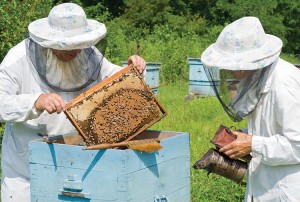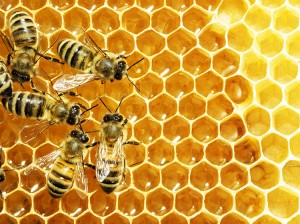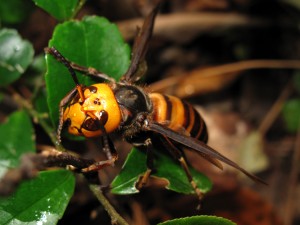A Vaccine to Save the Bees
Monday, January 30th, 2023
Beekeepers wear protective veils. Light-colored clothes help provide protection from stings. A few experienced beekeepers handle the bees and honeycombs with their bare hands.
Credit: © Shutterstock
You may have heard the phrase “Save the bees” before, but a vaccine for bees? That is something new! Honeybees in the United States have faced diseases and pests that have decimated the population. Bees are important and affect our daily lives. Bees pollinate plants and flowers, giving us food, medicine, and of course, pretty flowers. Recently, scientists at the Dalan Animal Health based in Athens, Georgia, created a vaccine to save the bees for real!
What is the vaccine for? We know about vaccines for the flu and COVID-19, this vaccine protects bees against American foulbrood. Since American foulbrood is caused by bacteria, the scientists figured out how to put the dead bacteria in the vaccine. When American foulbrood infects a hive, it causes the larva to be darker and gives the entire hive a rotten smell. American foulbrood can spread from hive to hive, wiping out colonies of 60,000 bees.
How do the scientists give the bees the vaccine? No, it isn’t a shot, and they will not have to invent little bandaids for the bees. The scientists put the dead bacteria into royal jelly, which is a sugar feed the queen bees eat. This process exposes the queen bee’s future offspring to the bacteria so the bees can make antibodies. Antibodies are proteins that help the immune system fight off bacteria and viruses.

A typical honey bee colony may include tens of thousands of workers. This photograph shows workers tending to honey stored in the cells of a honeycomb.
Credit: © StudioSmart/Shutterstock
Honeybees are important. They are vital to agriculture around the world. Without bees, the world would deal with more food scarcity. During their food-gathering flights, bees spread pollen from one flower to another, thus pollinating (fertilizing) the plants they visit. This allows the plants to reproduce. Numerous wild plants and such important food crops as fruits and vegetables depend on bees for fertilization. Honeybees pollinate nearly one-third of all food crops grown in the United States. Popular crops like almonds, apples, cherries, and pears require pollination from bees. Nearly three-quarters of all flowering plants rely on pollination from bees and other pollinators like butterflies and moths.
American foulbrood isn’t the only bee enemy. Bees are also declining in population due to climate change, disease, habitat loss, and pesticides. Beekeepers have given entire hives antibiotics to fight off diseases. However, the use of antibiotics can decrease beneficial bacteria and weaken the bees. Animals, mites, and human activities all threaten bees worldwide. There is also a disorder called Colony Collapse Disorder (CCD), an unusual condition that destroys hundreds of thousands of honey bee colonies each year in the United States. While the vaccine protects against American foulbrood, bees are also in danger of dying from European foulbrood. Diseases caused by fungi, such as Nosema disease, are also a threat to bees. Scientists hope the success of this vaccine will lead to others protecting the future of the bees!



